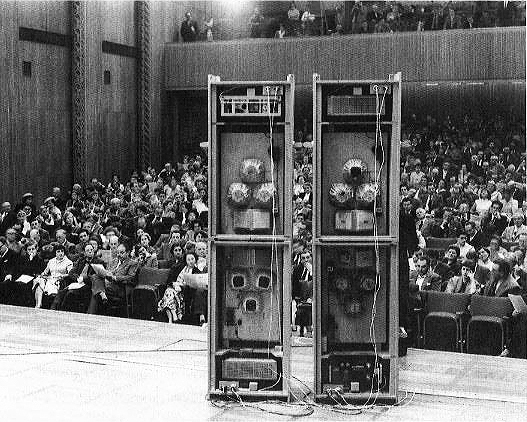|
|
| Fireproof Electrical Youths Kaspars Groševs, Artist Karlheinz Stockhausen. "Song of the Youths" (Gesang der Jünglinge, 1955-1956) | |
| It is highly unlikely that in the present day anyone needs an explanation of what electronic music is and at which point the power switch is turned on. It has saturated all the media and, thanks to the easily accessible technology, anyone can "compose music" these days. However, just sixty years ago electronic music was produced in special studios, and only a narrow circle of people had the opportunity to express themselves in that new and experimental field. While under the auspices of the French Radio in Paris Pierre Schaeffer was creating musique concrète by manipulating magnetic tape recordings, physicist Werner Meyer-Eppler and composer Herbert Eimert in Cologne conceived the idea of music created entirely from electronically produced signals. They called it elektronische Musik. The young composer Karlheinz Stockhausen moved to Cologne, where he wanted to pursue electronic music. That's where he created his musical composition "Song of the Youths". It is the first successful fusion of the pure sound of German elektronische Musik and the playful French experiments with magnetic tapes. The work consists of multiple recordings of a boy soprano. These recordings are altered and transposed, and, using electronic signals, language sounds are synthesized according to phonetic similarities - sine waves imitate the sung vowels, whereas filtered, electronically-generated noises mimic the consonants. | |
 World premiere in the large auditorium of Cologne's West German Radio on May 30, 1956 | |
| During the premiere Stockhausen executed his piece by combining five separate audio channels, it left a deep impression on the further development of music - the importance of spatiality in a musical composition was a new concept. The composer continued to experiment with spatiality throughout his career - one of the most striking examples is the piece he composed in the early 1990s - ‘Helicopter String Quartet' (Helikopter-Streichquartett), where each member of the quartet performs from a separate helicopter. The audience can view the process on video screens: the members leave the concert hall and go to their helicopters, and when they are airborne, the musical composition is performed, the sounds of the string instruments blending with the noise of the rotor blades. The piece is finished when the quartet has returned to the auditorium. Song of the Youths is a very interesting and suggestive piece from the musical point of view, with a good interplay between complex sound constructions and the content of the work. Stockhausen had intended the piece as an electronic version of the Catholic Mass but the Archbishop of Cologne was against using loudspeakers in church so the format was changed. The vocal part of the work is based on a Biblical story about three devout youths who refuse King Nebuchadnezzar's command to worship the image of gold, and are thrown into a blazing furnace. In the furnace the youths are protected by an angel, and they sing songs of praise to the Lord. In Stockhausen's composition, the voice of a young boy flickers ceaselessly in the flames, sometimes the sung words are broken up into syllables and phonemes, at other times, several voices can be heard simultaneously, with occasional comprehensible fragments which most often are - "praise the Lord" (preiset den Herrn). It remains a mystery whether or not the Catholic Church eventually agreed to have this work performed in a church. One thing is clear: if there is the opportunity, it is worth hearing this piece in a concert hall, performed in the exact way it had been intended by the author. /Translator into English: Vita Limanoviča/ | |
| go back | |







